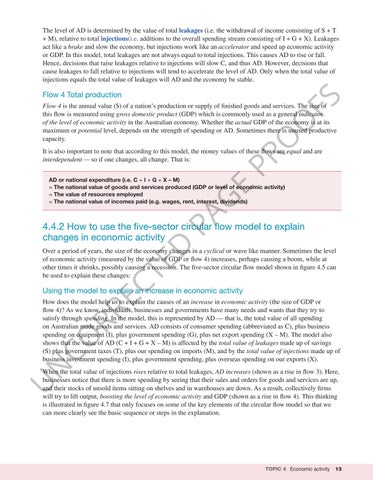“c04EconomicActivity_PrintPDF” — 2022/5/28 — 13:00 — page 13 — #13
The level of AD is determined by the value of total leakages (i.e. the withdrawal of income consisting of S + T + M), relative to total injections(i.e. additions to the overall spending stream consisting of I + G + X). Leakages act like a brake and slow the economy, but injections work like an accelerator and speed up economic activity or GDP. In this model, total leakages are not always equal to total injections. This causes AD to rise or fall. Hence, decisions that raise leakages relative to injections will slow C, and thus AD. However, decisions that cause leakages to fall relative to injections will tend to accelerate the level of AD. Only when the total value of injections equals the total value of leakages will AD and the economy be stable.
FS
Flow 4 Total production
O
O
Flow 4 is the annual value ($) of a nation’s production or supply of finished goods and services. The size of this flow is measured using gross domestic product (GDP) which is commonly used as a general indicator of the level of economic activity in the Australian economy. Whether the actual GDP of the economy is at its maximum or potential level, depends on the strength of spending or AD. Sometimes there is unused productive capacity.
PR
It is also important to note that according to this model, the money values of these flows are equal and are interdependent — so if one changes, all change. That is:
PA
G
E
AD or national expenditure (i.e. C + I + G + X – M) = The national value of goods and services produced (GDP or level of economic activity) = The value of resources employed = The national value of incomes paid (e.g. wages, rent, interest, dividends)
D
4.4.2 How to use the five-sector circular flow model to explain changes in economic activity
CO RR EC
TE
Over a period of years, the size of the economy changes in a cyclical or wave like manner. Sometimes the level of economic activity (measured by the value of GDP or flow 4) increases, perhaps causing a boom, while at other times it shrinks, possibly causing a recession. The five-sector circular flow model shown in figure 4.5 can be used to explain these changes:
Using the model to explain an increase in economic activity
N
How does the model help us to explain the causes of an increase in economic activity (the size of GDP or flow 4)? As we know, individuals, businesses and governments have many needs and wants that they try to satisfy through spending. In the model, this is represented by AD — that is, the total value of all spending on Australian made goods and services. AD consists of consumer spending (abbreviated as C), plus business spending on equipment (I), plus government spending (G), plus net export spending (X – M). The model also shows that the value of AD (C + I + G + X – M) is affected by the total value of leakages made up of savings (S) plus government taxes (T), plus our spending on imports (M), and by the total value of injections made up of business investment spending (I), plus government spending, plus overseas spending on our exports (X).
U
When the total value of injections rises relative to total leakages, AD increases (shown as a rise in flow 3). Here, businesses notice that there is more spending by seeing that their sales and orders for goods and services are up, and their stocks of unsold items sitting on shelves and in warehouses are down. As a result, collectively firms will try to lift output, boosting the level of economic activity and GDP (shown as a rise in flow 4). This thinking is illustrated in figure 4.7 that only focuses on some of the key elements of the circular flow model so that we can more clearly see the basic sequence or steps in the explanation.
TOPIC 4 Economic activity
13





















































